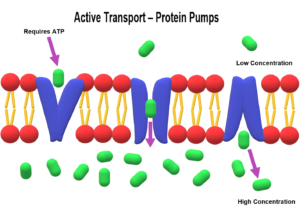Active transport
The movement of a substance across a biological membrane, such as living cells. Against a concentration (diffusion) gradient with the help of metabolic energy, usually provided by ATP (adenosine triphosphate). Active transport serves to maintain the normal balance of ions in cells, in particular ions of sodium and potassium. They play a vital role in nerve and muscle cells. Because a molecule is “pumped” across the membrane against its gradient with the help of metabolic energy.
The sodium-potassium “pump” that exchanges sodium (Na+) for potassium (K+) across the plasma membrane of animal cells is an example of the active transport mechanism.
It is the carriage of a solute across a biological membrane from low to high concentration that requires the expenditure of metabolic energy.





